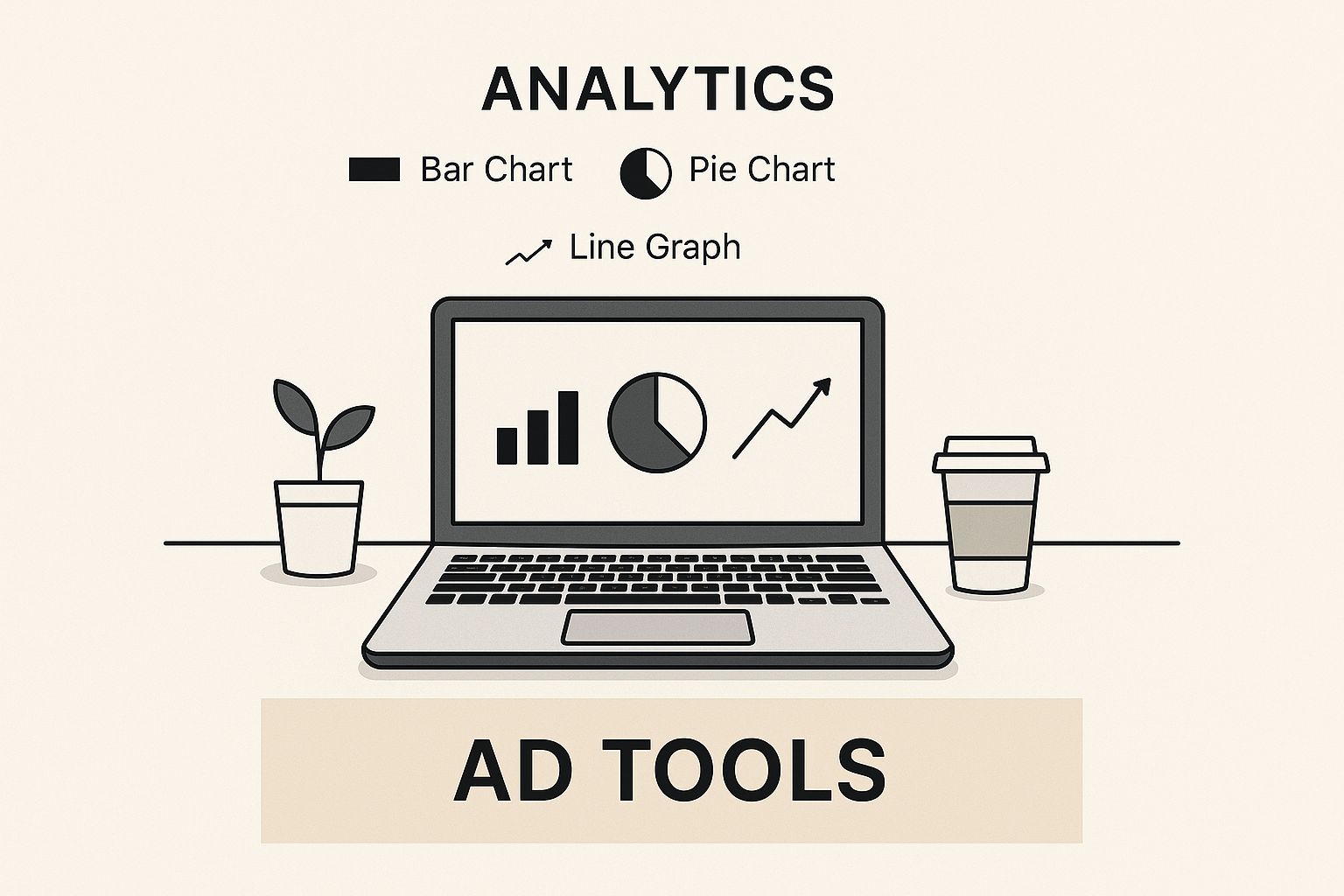How to Measure Advertising Effectiveness

To properly measure advertising effectiveness, you first need to define what you’re aiming for.Then, you track the specific numbers that show you’re getting there. It’s about shifting your focus from vanity metrics like views and impressions to the stuff that actually grows your business: things like lead generation, sales, and return on ad spend (ROAS).
Defining What Advertising Success Looks Like
Before you even think about spending a single pound on a new campaign, you need a rock-solid, crystal-clear picture of what success means for your business.
Trying to measure ad effectiveness without this foundation is like setting off on a road trip without a destination. You’ll see a lot of scenery (or in this case, a lot of data), but you’ll have no idea if you’re actually getting anywhere.
Success isn’t one-size-fits-all. For an e-commerce brand selling trainers, success is a direct sale from a Google Shopping ad. Simple. But for a B2B software company, it might be a qualified lead who downloads a whitepaper after clicking a LinkedIn ad. Your business model and the specific goals of your campaign completely dictate how you measure things.
Connecting Goals to Key Performance Indicators (How to Measure Advertising Effectiveness)
The most practical way to nail down what success looks like is by linking your big business goals to specific Key Performance Indicators (KPIs). Think of KPIs as the vital signs for your advertising campaigns – the hard numbers that tell you if you’re on the right track.
A really effective way to organise your thoughts is to bucket your KPIs into the three main stages of the customer journey:
- Awareness: This is all about getting in front of new people. The key metrics here are Reach (how many unique people see your ad) and Impressions (the total number of times your ad is shown).
- Engagement: Now you’re measuring how people are actually interacting with your ads. You’re looking at things like Click-Through Rate (CTR), likes, comments, and shares. A high CTR, for example, is a strong signal that your ad creative and messaging are hitting the mark with your target audience.
- Conversion: This is where the real magic happens—where your advertising spend turns into actual revenue. The crucial KPIs here are Cost Per Acquisition (CPA), Conversion Rate, and the all-important Return on Ad Spend (ROAS).
A classic mistake is getting fixated on awareness metrics without connecting them back to conversions. A massive reach looks great on a report, but it doesn’t mean much if it doesn’t ultimately contribute to your bottom line.
Beyond the Immediate Sale
Truly great advertising does more than just drive the next sale; it builds long-term value. When you’re defining success, you have to think about how your campaigns are boosting your brand’s reputation in the market. A big part of this is understanding how to measure brand equity, which your advertising heavily influences. When you have strong brand equity, customers will choose you over competitors and will even be willing to pay a bit more.
Ultimately, you want to draw a straight line from your ad spend to business growth. That means taking a deep dive into not just what you’re measuring, but why you’re measuring it. For a more detailed look at this, check out our guide on mastering ROI in paid advertising to connect your KPIs directly to financial returns. Get this framework sorted from the very beginning, and every metric you track will have a clear purpose.
How to Measure Advertising Effectiveness: Building Your Measurement Toolkit
Right, with your KPIs locked in, it’s time to get your tech sorted. To really get a grip on whether your ads are working, you need more than just the dashboards inside the ad platforms. You need a connected system that follows the entire customer journey from start to finish. Think of this toolkit as the foundation for gathering clean, reliable data.
The absolute centrepiece of any modern measurement setup is a solid web analytics platform. For most of us, that means Google Analytics 4 (GA4). It’s essential for figuring out what people do once they land on your site – tracking everything from simple page views right through to specific conversion events like someone filling out a form or buying a product.
But site analytics alone won’t cut it. You also need platform-specific trackers, often called pixels or tags. These little bits of code are what connect the dots between your ads and what happens on your website.
- Meta Pixel: If you’re running ads on Facebook or Instagram, this is non-negotiable. It lets Meta optimise your ad delivery for conversions and gives you the detailed reporting you need inside Ads Manager.
- LinkedIn Insight Tag: For B2B advertisers, this tag is crucial. It tracks conversions from your LinkedIn campaigns and even gives you demographic data about your site visitors. Invaluable stuff.
- TikTok Pixel: Essential for any brand advertising on TikTok. It helps you measure campaign impact and, just as importantly, build audiences for retargeting based on what users do on your site.
The Critical Role of UTM Parameters
Just installing these trackers isn’t enough, though. You have to actively tell your analytics tools where your traffic is coming from. This is where Urchin Tracking Module (UTM) parameters become your best friend.
Seriously, don’t skip this. These are just simple tags you add to the end of your ad URLs. They give you granular detail on the source, medium, and specific campaign that drove a click, allowing you to attribute performance properly. Without consistent UTM use, all your social traffic might just get lumped into one generic “social” bucket in GA4. Good luck figuring out if it was your paid LinkedIn campaign or an organic Facebook post that drove that last sale.
Your measurement is only as good as the data you feed it. Messy or inconsistent UTMs will lead to flawed analysis and, ultimately, poor decisions. Get a standardised naming convention sorted from day one and stick to it religiously.
For example, when running Google Ads, a meticulous setup is the only way to truly understand which campaigns are delivering the goods. Our guide on maximising your ROI with Google Pay-per-Click advertising strategies dives deeper into how to connect those ad clicks to real business outcomes.
Ultimately, building this toolkit is all about creating a seamless flow of data. When a user sees your ad, clicks it, and converts, your whole integrated system of pixels, UTMs, and analytics should capture that entire story. This complete picture is the key to accurately measuring your advertising effectiveness and making smarter choices to improve performance over time.
How to Make Sense of Your Campaign Performance Across Channels
Once your measurement tools are live, the real fun begins. You’re suddenly staring at a mountain of data, but raw numbers on a screen don’t tell you the whole story. The trick is to turn that data into genuine insights—to understand not just what happened, but why it happened.
To do this properly, you need to look beyond the dashboards of individual platforms. True performance analysis means comparing results across all your channels, appreciating the unique role each one plays in your marketing mix. This is a non-negotiable step if you want to truly measure your advertising effectiveness.
It’s Not About Comparing Apples and Oranges (How to Measure Advertising Effectiveness)
It’s incredibly tempting to judge every channel by the same metric, like Return on Ad Spend (ROAS). Honestly, it’s one of the most common mistakes I see people make. The reality is that different channels are built for different jobs.
- High-Intent Channels (think Google Search Ads): These are fantastic for capturing demand that’s already there. Someone typing “best running shoes for flat feet” into Google is pretty far down the buying path. For these channels, you’d rightly expect a high ROAS and a quick conversion.
- Brand-Building Channels (like Social Media & Display Ads): These are your workhorses for creating future demand and getting your brand name out there. A person casually scrolling through Instagram isn’t in ‘buy now’ mode, so a lower immediate ROAS is completely normal. Here, you should be looking at metrics like engagement rate, reach, and video completion rates.
The goal isn’t to crown one “best” channel and ditch the rest. It’s about understanding how they all work in harmony. A brilliant social media campaign might not drive sales today, but it could introduce your brand to thousands of people who then Google you next week.
This is where having a central hub for your data becomes crucial. You need a way to pull everything together for a clear, unified view.
As you can see, analytics platforms sit at the heart of this process, consolidating data from all your advertising tools to give you that single source of truth.
Spotting Trends and Finding the Outliers
With a proper cross-channel view, you can finally start digging for gold. Look for patterns in your data over time. Is your cost per acquisition (CPA) on Facebook ads slowly creeping up? Maybe your audience is getting tired of seeing the same ads, and it’s time for a creative refresh.
Let me give you a real-world example. An e-commerce brand I worked with noticed a specific TikTok video was getting tons of likes and shares but very few direct sales. At the same time, a simple static image ad on Instagram was delivering a fantastic ROAS. The insight here was clear: the TikTok video was an amazing awareness-driver, but the Instagram ad was the closer. So, what did we do? We set up a retargeting campaign showing the high-converting Instagram ad specifically to people who had engaged with the TikTok video. It worked a treat.
This kind of thinking is especially important in the UK market. If you look at the ad spending data, you’ll see clear channel strengths. Search advertising spend grew consistently between 2019 and 2023, proving its power for capturing existing intent. At the same time, social media and digital video revenue are projected to keep climbing through 2028, showing their growing importance for brand building. You can dig deeper into UK advertising trends on Statista.com.
To help, here’s a quick breakdown of how different ad formats in the UK typically perform and what you should be measuring.
UK Digital Advertising Format Performance Indicators (How to Measure Advertising Effectiveness)
| Ad Format | Primary Objective | Key Effectiveness KPIs |
|---|---|---|
| Search Ads | Capture existing demand, drive sales/leads | ROAS, CPA, Conversion Rate, Click-Through Rate (CTR) |
| Social Media Ads | Build brand awareness, community engagement | Engagement Rate, Reach, Impressions, Cost Per Mille (CPM) |
| Video Ads | Tell a story, create emotional connection | Video Completion Rate (VCR), View-Through Rate (VTR), Brand Lift |
| Display/Banner Ads | Broad reach, top-of-funnel awareness | Impressions, Reach, CPM, CTR |
| Shopping Ads | Drive e-commerce sales directly | ROAS, Conversion Value, Cost of Sale (CoS) |
This table isn’t exhaustive, but it gives you a solid starting point for aligning your metrics with the actual job of each ad format.
Moving Beyond the Last Click
One of the biggest traps in digital marketing is last-click attribution—giving 100% of the credit for a sale to the very last ad a customer clicked. This model completely ignores all the hard work done by other channels earlier in the customer’s journey. It’s a dangerously simplistic view.
To get a more accurate and strategic picture, you need to think about the entire customer journey. This is where calculating Customer Lifetime Value (CLV) becomes an absolute game-changer. CLV tells you the total revenue you can expect from a single customer over the entire course of their relationship with your brand.
When you start calculating CLV for customers acquired through different channels, you might discover something fascinating. You may find that while your search ads bring in quick, one-off sales, the customers you acquire through your LinkedIn campaigns stick around longer and have a much higher lifetime value. In the long run, those LinkedIn customers are far more valuable. This long-term perspective is a much more sophisticated—and profitable—way to measure advertising effectiveness.
How to Measure Advertising Effectiveness: Using Advanced Measurement Techniques
Basic metrics are a fantastic starting point, but if you want to truly understand the real impact of your ad spend, you need to dig deeper. Relying on last-click attribution alone is like crediting only the final striker for winning a football match—it completely ignores the brilliant midfield play and solid defence that made the goal possible. To accurately **measure advertising effectiveness**, we have to move beyond this simplistic view.
This is where attribution modelling comes in. Think of it as a way of fairly assigning credit to the various touchpoints a customer interacts with on their journey to becoming a customer. Instead of giving 100% of the value to the final click, you can distribute it across the entire path.
Moving Beyond the Last Click
Several attribution models offer a more nuanced perspective than the outdated last-click approach. Each one provides a different lens through which to view your data, and the right choice depends entirely on your business model and campaign goals.
- Linear Model: This model gives equal credit to every single touchpoint in the conversion path. It’s a great, simple starting point for understanding the full customer journey.
- Time-Decay Model: Here, the touchpoints closest in time to the conversion get the most credit. This is useful for shorter sales cycles where the interactions just before the purchase are arguably more influential.
- Data-Driven Model: This is the most sophisticated option, available in platforms like Google Ads. It uses machine learning to analyse your specific account data and assign credit based on how each interaction actually contributed to conversions.
By exploring different attribution models, you’ll uncover which channels are quietly doing the heavy lifting at the start of the customer journey. You might find your social media campaigns, which looked poor on a last-click basis, are actually introducing a huge number of your most valuable customers.
Proving Your Ads Really Work with Incrementality
Attribution tells you which channels get credit for a conversion, but it doesn’t answer a more fundamental question: did your ads cause the conversion to happen at all?
This is where incrementality testing comes into play. It’s all about figuring out the sales you generated that would not have happened without your advertising. Simple as that.
The most common way to measure this is through A/B testing or, on a larger scale, lift studies. In a lift study, you split your audience into two groups: one that sees your ads (the test group) and one that doesn’t (the control group). By comparing the conversion rates between the two, you can measure the “lift”—the real, incremental impact of your campaign.
This methodical approach is vital in a competitive environment like the UK advertising market. For instance, in Q1 2024, UK ad expenditure hit a record £9.2 billion, a 9.3% increase year-on-year. With online formats making up nearly 80% of that spend, proving the incremental value of each pound is essential for justifying budgets and driving growth. You can read more about these UK advertising spend findings to understand the market pressures.
A well-structured A/B test or lift study gives you undeniable proof of your ad’s value. It moves the conversation with stakeholders from “How much did we spend?” to “Look at the extra revenue we generated.” For any team looking to scale their efforts effectively, this is a crucial step.
For a deeper dive into ensuring your campaigns are set up for success, check out our guide on what every UK digital marketer needs in their Google Ads audit checklist.
How to Report and Communicate Your Findings
Pulling all that performance data together is a great first step, but it’s only half the battle. Your brilliant analysis is completely wasted if those insights just sit gathering dust in a spreadsheet. To truly measure advertising effectiveness, you have to communicate your findings in a way that’s clear and persuasive to the people holding the purse strings.
This isn’t about just exporting a few charts. It’s about storytelling with data. Your job is to turn a sea of complex metrics into a compelling narrative that shows what worked, what flopped, and—most importantly—what we should do next.
Tailoring Your Story for the Right Audience (How to Measure Advertising Effectiveness)
The number one rule of reporting? Know your audience. The nitty-gritty, granular data that gets your marketing team excited is the same data that will make a C-suite executive’s eyes glaze over. You’ve got to tailor your communication style and the level of detail to who you’re talking to.
- For the Marketing Team: This is where you can really get into the weeds. Dive deep into A/B test results for ad creative, specific keyword performance, and channel-specific CPAs. This lot needs all the details to make tactical tweaks and optimisations.
- For the C-Suite: They need the big picture, fast. Focus on the top-line metrics that tie directly to business goals—things like overall ROAS, how advertising is feeding the sales pipeline, and any gains in market share. You need to speak their language: revenue and profit.
The best reports don’t just dump data on people; they offer a clear point of view. Kick things off with your most important takeaway, then use the data to back up your conclusion. This ensures your key message lands, even if they only have time to skim the report.
Building Dashboards for At-a-Glance Insights
For ongoing reporting, a live, visual dashboard is your best mate. Tools like Google Looker Studio, or even a really well-organised spreadsheet, can provide a clear, at-a-glance view of how you’re tracking against your most important KPIs. This saves you from the mind-numbing task of manually pulling reports and gives stakeholders instant access to the numbers they actually care about.
When you’re building your dashboard, keep it simple. Clarity is king. Use charts and graphs to make trends pop, and stick your primary KPIs right at the top where no one can miss them. This kind of proactive transparency builds a massive amount of trust and keeps everyone on the same page.
Of course, before you present any of this, it’s always smart to make sure your own house is in order. Running a quick check with a comprehensive https://ppcgeeks.co.uk/ppc/ppc-audit-checklist/ can help you spot any potential issues before they become awkward talking points in a meeting.
It’s also crucial to add context from the wider market to tell the full story. For example, data from the AA/WARC Expenditure Report projects that UK ad spend will hit a staggering £45.2 billion in 2025. Knowing that the entire industry is investing more helps frame your own budget requests and puts your performance into perspective.
Ultimately, effective communication is what turns your measurement efforts into strategic action. It’s the final, critical step that makes sure your insights drive smarter decisions, fuel continuous optimisation, and prove the undeniable value of your advertising.
Frequently Asked Questions (How to Measure Advertising Effectiveness)
Even with a solid framework for measuring your ads, some tricky questions always seem to pop up in practice. We get asked these all the time, so here are some straight-talking answers to the most common challenges marketers face.
How Do I Measure Ads with Growing Data Privacy Changes?
Let’s be honest, navigating the new world of data privacy can feel like a headache. With Apple’s iOS updates and the slow death of third-party cookies, the old ways of tracking are on their way out. The key is to stop trying to follow every individual user and start looking at the bigger picture.
This means you’ll need to lean more on the tools built for this new reality. Things like the Privacy Sandbox’s Attribution Reporting API are designed to give you performance insights without peeking into individual user data. More importantly, it’s time to double down on your own first-party data—the information you collect directly from customers on your website, in your CRM, or through your email list. This is your gold mine in a privacy-first world.
The future of measurement isn’t about tracking every single click in a user’s journey. It’s about using privacy-safe tech and your own data to make smart, directional decisions about where your budget is working best.
How Can I Track the Impact of Offline Campaigns?
Ah, the classic marketing problem: what about that billboard on the M6 or the ad you ran on the local radio? Connecting offline ads to your digital results might seem impossible, but you can get a surprisingly clear picture with a few clever tactics.
One of the most reliable methods is using unique, memorable vanity URLs or dedicated landing pages. For example, in a magazine ad, you might say, “Visit BrandName.co.uk/Summer”. You can also use campaign-specific discount codes or QR codes. By tracking how many people use these unique signposts, you can directly attribute website traffic and sales back to a specific offline channel.
What’s a Sensible Budget for Testing and Measurement?
Figuring out how much to set aside for testing new ideas and measurement tools is always a balancing act. There’s no magic number that fits everyone, but a solid rule of thumb is to dedicate 10-15% of your total advertising budget to experimentation and measurement.
This isn’t just for buying new software. That budget covers the cost of running A/B tests (where one version will inevitably underperform), funding lift studies, or even dipping your toes into a new ad channel. Think of it as your “intelligence budget.” The insights you get from a well-funded testing programme will almost always pay for themselves by making the other 85-90% of your ad spend work much, much harder.
Ready to stop guessing and start getting real, data-driven results from your ad spend? The team at PPC Geeks specialises in building transparent, effective measurement strategies that drive growth. Start with a free, in-depth PPC audit today and see exactly where you can improve.
Author
Search Blog
Free PPC Audit
Subscribe to our Newsletter
The Voices of Our Success: Your Words, Our Pride
Don't just take our word for it. With over 100+ five-star reviews, we let our work-and our satisfied clients-speak for us.
"We have been working with PPC Geeks for around 6 months and have found Mark and the team to be very impressive. Having worked with a few companies in this and similar sectors, I rate PPC Geeks as the strongest I have come across. They have taken time to understand our business, our market and competitors and supported us to devise a strategy to generate business. I value the expertise Mark and his team provide and trust them to make the best recommendations for the long-term."
~ Just Go, Alasdair Anderson



